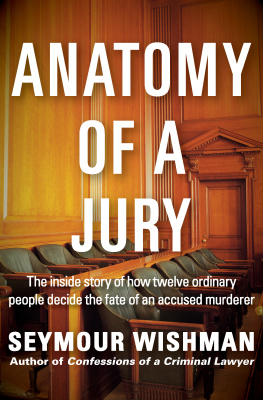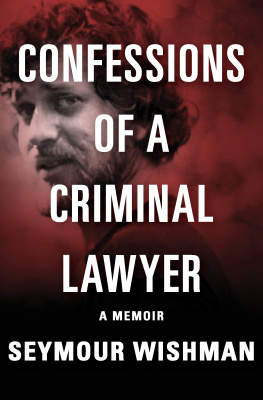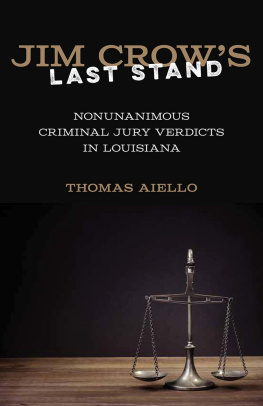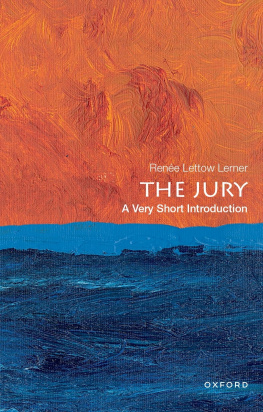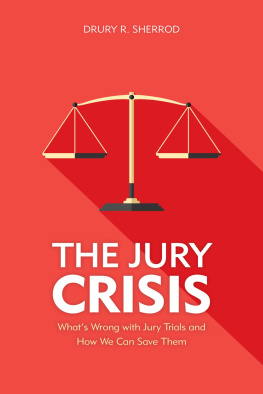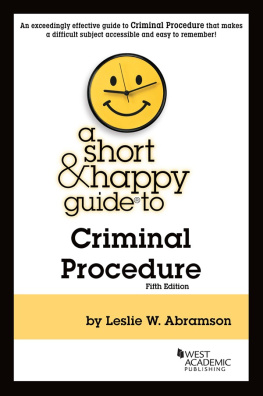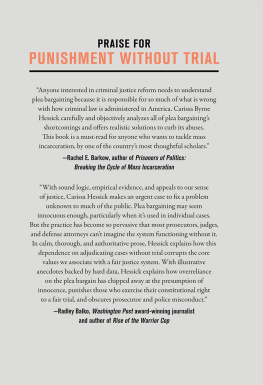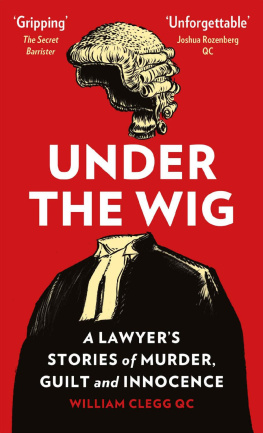
Anatomy of a Jury
Seymour Wishman

To Pauline and Isadore Wishman
PREFACE
I HAVE BEEN A criminal lawyer for twenty years. I have tried hundreds of cases before juries, both as a prosecutor and as a defense lawyer. Juries have fascinated me not only for what they reveal about our idea of justice, but for what they tell us about ourselves. I decided to write a book that would show something about how we administer justice, and, perhaps just as important, how we judge others and how others perceive and judge us.
Every year more than 1,200,000 people in America place their hands on Bibles and swear they will decide with fairness whether or not thousands of their fellow citizens are guilty of murder, rape, robbery, or other crimes. Twelve strangers without special skill or training are called upon to exercise their sense of justice and draw on their most astute perceptions of people. Each jury in its own way represents the best and worst of us as a society.
The jury systemour substitute for trial by ordealhas been venerated over the centuries by respected authorities. To William Blackstone, the great English legal commentator of the eighteenth century, the jury was a palladium of liberty; Jefferson called it a touchstone ensuring our peace and safety; more recently, the British jurist Patrick Devlin has described the jury system as the lamp that shows that freedom lives. To thousands of lawyers, judges, and average citizens, however, the jury is seen as twelve prejudiced, gullible dolts incapable of understanding the evidence or law involved in a case.
While the merits of the jury are hotly debated in legal and nonlegal circles, these ordinary people are deliberating in secret and announcing, without explanation, verdicts affecting the lives and sometimes the deaths of perfect strangers. If any of us are ever accused of a crime, these ordinary people will determine our guilt or innocence. Their power is enormous, far greater than any power most of us exercise either before or after jury service. And when it is over, after this most intense, often humbling, experience, they resume their normal routines.
When I was considering how to write a book about the jury system, I soon realized that it could not be a dissertation full of legal abstractions. If I restricted myself to my own past dealings with juries and exhaustive research, the book would lose the immediacy and vividness of the actual experience of jurors.
I decided to describe a real trial through all its stages, using that case as a vehicle to discuss along the way the various issues involving juries. A criminal trial is inherently dramatic. The plot unfolds in regular scenes of neat acts, all leading to a climax of great consequences. The actors in the trialthe lawyers, the judge, the witnesses, the jurorshave clearly defined roles, and whether or not they perform well, all are interesting.
In many respects it didnt matter which case I chose. The basic legal principles and procedure are the same for all criminal trials, and the jurors involvement is the same regardless of the charge. I decided on a murder case because of the high stakes, and I felt it was important to have a trial that was typical so as to be representative, yet complex enough to involve a range of questions affecting the jury.
So I chose a case that seemed to suit my purpose, and followed the trial. When it was all over, I realized that several important issues had simply not come up. It had been unrealistic of me to think that any one trial could furnish the opportunities to cover all the topics I wanted to discuss. At that point I decided to observe several more trials and then bring in some of my personal experiences, and in this way tailor a more perfect case.
The result is a composite case, most of which is derived from a single trial. All the characters are real, but a few have been drawn from different cases. I cannot claim that this is a documentary case, but I can assert that I have seen all of the events described in it at one time or another. The trial is intended only as a vehicle to illustrate aspects of the jury system as a whole. The names of all the characters in the trial have been changed.
PART ONE
Who Shall Judge Me?
CHAPTER I
JOHN MINTON, ALONE IN his police car, drove slowly through the quiet streets of Glen Ridge, New Jersey, in the middle of a hot, humid afternoon. It was September 5, 1982, the day the case against Leander Rafshoon began.
Minton had been on the police force of this wealthy residential community for eighteen years, and an air-conditioned vehiclethe prize for years of faithful servicehad still, somehow, eluded him. His blue short-sleeved shirt, now soaked with sweat, stuck to the vinyl of the back of the seat.
Minton glanced admiringly, protectively, at the stately fifty-year-old mansions of red brick with stone turrets and gray slate roofs, Tudor or Colonial in designor the best of botheach house, he knew, with its own carpeted recreation/family room in the basement, many of the houses with brick patios and colorful umbrellas over round white tables, some of the homes with pools in the backyard, and all surrounded by high, carefully trimmed hedges. Glen Ridge is a town of bankers and brokers and business executives whose wives fill their days preparing for charitable events and interesting cultural projects and programs of physical fitness. When the children are at school, the streets are silent except for an occasional delivery, or the mailman, or the coming or going of a maintenance man.
John Minton knew the town, virtually every family and every street within the two square miles. They were good people and it was a good community, a peaceful world totally foreign to the danger of violence so common in a place like Newark, only a few miles to the east.
In another four years Minton was to retire from the force and settle into a sedentary job as a guard in a cool, quiet bank. But in a few minutes he would become involved in the most brutal crime of his career, an act of bloody violence that would horrify the good people of Glen Ridge and leave them unable ever again to feel fully secure in their homes.
As Mintons car edged along the tree-lined street, Adam Collins, two blocks away on a parallel street, walked up the slate path to the main entrance of a large brick house. Adam had decided to skip swimming practice and go directly home from school. He was a shy, strikingly handsome, well-behaved boy of fourteen just starting his sophomore year in high school.
Adam closed the front door behind him. From the center hall he saw on the bottom step of the staircase the end of a black and white rope. He called for his mother. No one answered. He followed the rope around the doorframe to the corridor leading to the kitchen. He started to reach down to pick up the rope, but something kept him moving forward in the direction of the kitchen toward which the rope snaked a path.
What Adam then saw was a scene of horror worse than any nightmare. The kitchen table and one of the chairs were knocked over. Pools of blood covered parts of the black tile floor. In the center of the room was his mother naked, on her stomach, with blood all over her back. Her head, just above her right temple, was smashed in, and her blond hair was soaked in coagulating blood. The long rope he had followed from the staircase in the center hall ended around her neck.
Adam began to scream.
Next page
